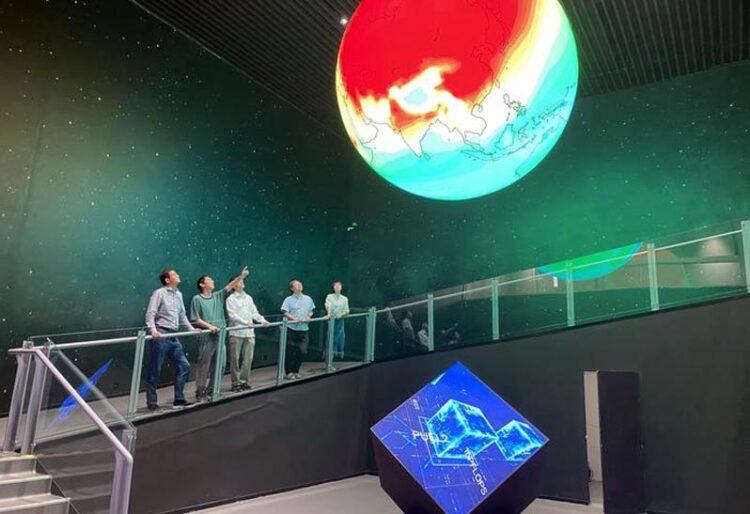CAS-ESM2 breakthrough: accurate simulation of atmospheric CO2

The CAS-ESM team discussed the simulation results of fully coupled atmospheric CO2 seasonal variations while examining visualizations on the suspended dome screen at the Earth System Numerical Simulation Facility (EarthLab).
Credit: Guoqiang Li
The Chinese Academy of Sciences Earth System Model (CAS-ESM2.0), a sophisticated Earth modeling tool, has achieved a major breakthrough in fully coupled atmospheric CO2 simulation, as revealed in the latest report published in Advances in Atmospheric Sciences on Sept. 22.
The study was conducted by researchers from the Institute of Atmospheric Physics of the Chinese Academy of Sciences, Beijing Normal University and Stony Brook University.
Their findings highlight CAS-ESM2.0’s exceptional capability in two-way coupling of terrestrial and marine carbon cycles, along with atmospheric CO2, enabling accurate spatiotemporal assessments of atmospheric CO2 changes.
Atmospheric CO2, a pivotal greenhouse gas, has surged since the Industrial Revolution, significantly affecting both the global climate, leading to warming through the greenhouse effect, and ecosystems by enhancing plant photosynthesis. It remains central to worldwide climate and environmental research.
Earth system models play a vital role in studying atmospheric CO2 concentration changes and their complex interactions with climate across different spatiotemporal scales. Achieving full coupling of atmospheric CO2 in these models has long been a challenge, particularly in emissions-driven simulations, where CO2 interacts with land and ocean carbon cycles. This complexity presents numerous challenges and uncertainties.
Over several decades, CAS-ESM has undergone continuous development, culminating in the release of CAS-ESM2.0. This latest version has completed the sixth phase of the Coupled Model Intercomparison Project (CMIP6) Diagnosis, Evaluation, and Characterization of Klima (DECK) simulations (concentration-driven runs) and submitted the results to CMIP6.
The team’s subsequent efforts focused on enhancing CAS-ESM2.0 to achieve two-way coupling among atmospheric CO2, the physical climate system, and the carbon cycle in land and ocean. This breakthrough empowers CAS-ESM2.0 to simulate CO2-carbon-climate interactions and autonomously calculate atmospheric CO2 concentrations.
Leveraging CAS-ESM2.0’s capabilities, the researchers conducted a coupled carbon-climate simulation in alignment with CMIP6’s historical emissions-driven experiment proposal. The results are remarkable, with CAS-ESM2.0 demonstrating excellent agreement with observations, accurately reproducing the rising trend of annual CO2 levels from 1850 to 2014 and capturing the seasonal CO2 cycle.
CAS-ESM’s potential applications, given its ability to simulate CO2-carbon-climate interactions, are manifold. It offers a valuable tool for investigating scientific issues related to carbon-climate interactions, enabling quantification of model biases associated with specific processes, such as fire and vegetation dynamics, and revealing the underlying mechanisms.
Furthermore, CAS-ESM holds promise in supporting China’s goal of carbon neutrality. By employing CAS-ESM to assess net carbon fluxes at each stage of the carbon-neutrality journey, policymakers can receive invaluable insights to refine strategies on carbon neutrality.
DOI: 10.1007/s00376-023-3172-9
Article Title: CAS-ESM2.0 Successfully Reproduces Historical Atmospheric CO2 in a Coupled Carbon-Climate Simulation
Article Publication Date: 22-Sep-2023
Media Contact
Zheng Lin
Institute of Atmospheric Physics, Chinese Academy of Sciences
jennylin@mail.iap.ac.cn
Office: 01-082-995-053
All latest news from the category: Ecology, The Environment and Conservation
This complex theme deals primarily with interactions between organisms and the environmental factors that impact them, but to a greater extent between individual inanimate environmental factors.
innovations-report offers informative reports and articles on topics such as climate protection, landscape conservation, ecological systems, wildlife and nature parks and ecosystem efficiency and balance.
Newest articles

Properties of new materials for microchips
… can now be measured well. Reseachers of Delft University of Technology demonstrated measuring performance properties of ultrathin silicon membranes. Making ever smaller and more powerful chips requires new ultrathin…

Floating solar’s potential
… to support sustainable development by addressing climate, water, and energy goals holistically. A new study published this week in Nature Energy raises the potential for floating solar photovoltaics (FPV)…

Skyrmions move at record speeds
… a step towards the computing of the future. An international research team led by scientists from the CNRS1 has discovered that the magnetic nanobubbles2 known as skyrmions can be…





















